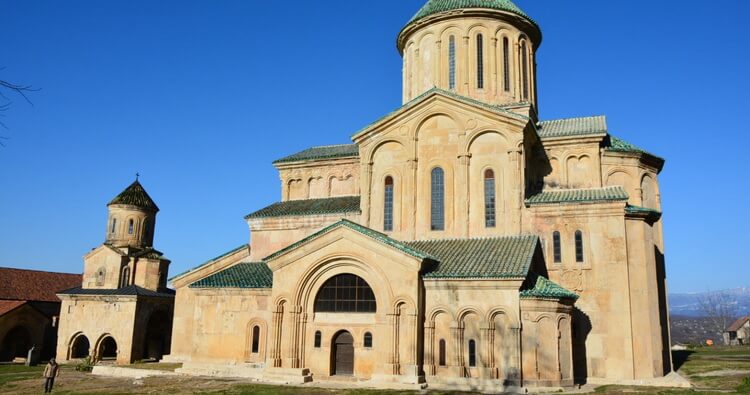Gelati UNESCO site rehabilitation organisation: roof defects "impossible to predict"

The Gelati Monastery has been under rehabilitation since 2008, with work on the roof taking place over the last few years. Photo via Georgian Arts & Culture Center.
The organisation involved in rehabilitation works on western Georgia's Gelati Monastery Complex has said damage to roof tiling of the monument, which led to rainwater leakage reported last week, was "impossible to predict", with planning for fixing the damage still ongoing.
The Georgian Arts & Culture Center, the contractor working on a new tiled roof of the UNESCO World Heritage Site which, released its response to criticism of its handling of the work on Sunday, outlining the process of creation and inspection of the tiles that were damaged by adverse weather throughout last winter.
In its statement, the centre said none of the tiles later revealed to have failed had shown signs of visual defects during inspection after they were produced, and had undergone laboratory testing on "mechanical characteristics" before being used in the rehabilitation works.
The release also noted a "powerful hydro insulation layer" under the tiles had worked as intended, minimising leaks through the roof and into the building.
A plan for resolving issues with the roof tiling is being prepared by professionals, the centre said, adding that all decisions made on the monument involved a group of "best experts of the field", including in architecture, restoration, construction, geology, hydrology and landscaping.
Rainwater leak and fresco damage was reported from the monument last week, with the National Agency for Cultural Heritage Preservation of Georgia later releasing its comments. However the heritage agency and independent professionals disagreed on various aspects of the issue.
The monastery will now see a temporary roofing built over it, before the roof tiling on the St Mary Temple, the principal part of the complex, is completely replaced.
Rehabilitation of Gelati, a major work of national importance, was launched in 2008 and involved both state and international support, including from the World Bank, the Ambassador's Fund for Cultural Preservation at the United States Embassy in Tbilisi, and the Municipal Development Fund of Georgia.
Rehabilitation of the St Mary Temple was started four years ago, with professionals involved in the work using roof tiling made to resemble tiles discovered around the site in the mid-1980s and considered to have been used in the original roofing of the 12th century building.
The Gelati complex had been part of the UNESCO World Heritage List since 1994, when it shared the spot with the nearby 11th century Bagrati Cathedral. They were placed in the UNESCO list of endangered sites in 2010, when government-led restoration works, initiated in defiance of UNESCO regulations, led to the international organisation's warnings on "irreversible interventions carried out on the site".
Following years of work by the new Georgian government, Gelati was re-accepted in the World Heritage List as a separate monument, with the decision announced at the 41st UNESCO World Heritage Committee meeting in Krakow, Poland in 2017.
Located outside the western Georgian city of Kutaisi, the monastery is noted by the UNESCO for representing "the masterpiece of the architecture of the 'Golden Age' of Georgia and the best representative of its architectural style".
 Tweet
Tweet  Share
Share